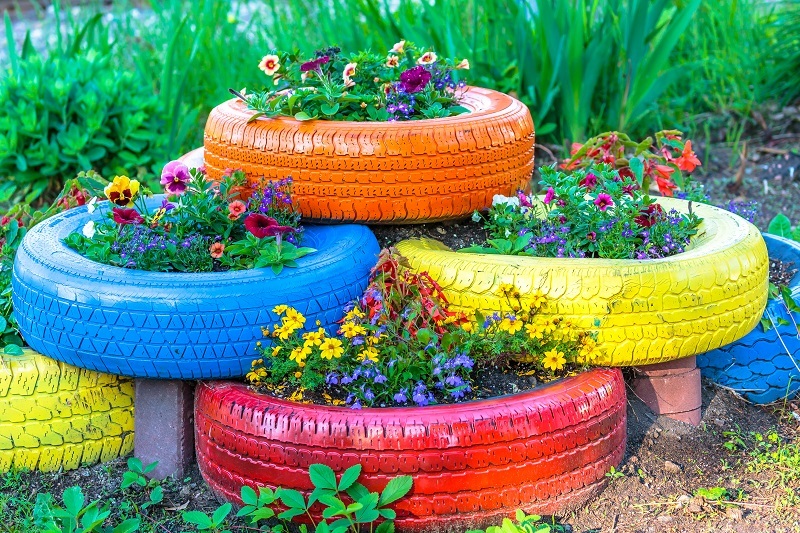Maximize the Lifespan of Your Poinsettias
Posted on 01/07/2025
Maximize the Lifespan of Your Poinsettias: The Ultimate Guide
Poinsettias, with their iconic red and green foliage, are undoubtedly one of the most popular holiday plants. Many people purchase these vibrant plants in the winter with the expectation that they'll last just a few weeks, only to discard them after the holidays. However, maximizing the lifespan of your poinsettias is entirely possible--and incredibly rewarding. With proper care, you can enjoy their colorful beauty throughout the year, and even encourage reblooming come next season.
Understanding Poinsettias: More than a One-Season Plant
Poinsettias (Euphorbia pulcherrima) are native to Mexico and Central America. Their vibrant color is often mistaken for flowers, but those are actually bracts--specialized leaves. The tiny yellow centers are the actual flowers. Recognizing their origins and growth patterns is key to prolonging their life indoors.
- Bracts provide color and act as the plant's main visual attraction.
- The actual flowers (cyathia) are yellow and reside in the center of the bracts.
- Poinsettias are perennials in their native habitat, thriving year after year.
With this in mind, let's dive into the comprehensive strategies to extend the lifespan of your poinsettias and enjoy their festive charm well past the holiday season.

Choosing the Healthiest Poinsettia: The First Step to Longevity
The secret to maximizing poinsettia longevity starts even before you bring a plant home. Make a wise choice at the garden center or nursery.
What to Look for When Buying Poinsettias
- Vibrant, unblemished leaves (avoid yellowing, wilting, or spots)
- Tightly clustered yellow flowers (the true flowers should not be faded or falling out)
- Sturdy stems and even growth
- No signs of pests or disease on leaves or stems
Take care to wrap your plant in paper when transporting it in cold weather--poinsettias are highly sensitive to cold drafts and can be easily damaged even during a short exposure.
Creating the Optimal Indoor Environment
Once you've selected a robust specimen, it's time to maximize the lifespan of your poinsettia by replicating its ideal surroundings indoors.
Lighting Needs: Placement Matters
Poinsettias flourish in bright, indirect sunlight. Too little light can cause leaves to yellow and drop, while too much can burn the bracts.
- Place them near a sunny window (south, east, or west facing is ideal).
- Avoid direct sunlight, which can damage delicate leaves and bracts.
- Rotate the pot regularly so all sides receive equal light.
Maintaining the Right Temperature
Temperature plays a vital role in prolonging the life of poinsettias.
- Ideal daytime temperature: 65-70?F (18-21?C)
- Nighttime temperature: 60-65?F (15-18?C)
- Avoid sudden temperature changes, drafts, and heat sources such as radiators and fireplaces.
*Poinsettias are sensitive to both cold and hot air currents. Even a few minutes in a draft or near a heat vent can cause their bracts and leaves to droop or drop.*
Optimal Humidity
Poinsettias thrive in moderate humidity. Dry air (especially in winter) can result in leaf drop.
- Place a humidifier nearby or set the pot on a tray of pebbles filled with water, ensuring the pot does not sit directly in water.
- Mist the leaves occasionally with lukewarm water.
Watering Techniques for Long-Lived Poinsettias
Overwatering is the number one killer of indoor poinsettias. To really maximize the lifespan of your poinsettias indoors, a consistent yet cautious watering routine is essential.
- Check the soil daily--water only when the top inch feels dry to the touch.
- Water thoroughly, allowing excess water to drain completely (never let the pot sit in standing water).
- Empty saucers after any water drains through.
- Use room-temperature water to avoid shocking the roots.
*Pro tip: If the plant comes with a decorative foil wrap, poke drainage holes, or remove it entirely when watering to prevent roots from suffocating.*
Fertilizing for Year-Round Vigor
If you intend to keep your poinsettia past its blooming season, fertilization becomes important after the holidays.
- Began feeding with a balanced, water-soluble houseplant fertilizer once new growth appears (usually in late winter or early spring).
- Follow label instructions to avoid over-fertilizing, which can harm the plant.
- Fertilize every two to three weeks during active growth periods.
Never fertilize when the plant is still blooming or immediately after bringing it home! Wait until the blooms have faded and active growth resumes.
Repotting and Pruning for Extended Longevity
When and How to Repot Your Poinsettia
To ensure robust growth, repot your poinsettia every one to two years, ideally in spring, once it's finished blooming.
- Select a pot that is 1-2 inches larger in diameter than the previous one.
- Use a high-quality, well-draining potting mix.
- Gently tease out the root ball, trim away any dead or mushy roots, and place into the new pot.
- Water thoroughly and place in bright, indirect light.
Pruning for Health and Shape
Pruning is essential to maximize poinsettia lifespan and encourage bushy growth.
- Once the bracts start to fade (usually late winter or early spring), cut the stems back to about 4-6 inches tall.
- This stimulates new growth from the base and helps maintain a compact form.
- Repeat light pruning every couple of months to encourage fullness.
Encouraging Reblooming: The Advanced Gardener's Method
The biggest challenge in caring for poinsettias year-round is making them rebloom. Poinsettias are photoperiodic--which means they require specific light and dark conditions to develop new bracts for the next holiday season.
How to Make Poinsettias Rebloom
- Starting in late September, give your plant 14-16 hours of complete darkness each day. Place it in a closet, under a box, or in a dark room every evening.
- During the day, return it to a sunny location for the remaining 8-10 hours of light.
- Maintain absolute darkness (no street lights, night lights, or even brief flashes of light) for this period--about 8 to 10 weeks.
- Continue normal watering and fertilizing during this time.
After 8-10 weeks, you should see beautiful new bracts forming, ready to brighten your home again just in time for the holidays.
Common Poinsettia Problems and Their Solutions
Even with ideal care, you may encounter some issues. Here's how to troubleshoot and maximize the lifespan of your poinsettia plants:
-
Leaf Drop:
- Often caused by exposure to cold drafts, overwatering, underwatering, or sudden temperature changes.
- Solution: Review your placement, watering routine, and room temperature.
-
Yellowing Leaves:
- May result from inconsistent watering, too little light, or nutrient deficiencies.
- Solution: Adjust watering and fertilization, and relocate plant to a brighter spot if needed.
-
Pests (such as whiteflies, spider mites, or mealybugs):
- Inspect leaves regularly. Remove pests by rinsing with water, wiping with rubbing alcohol, or using insecticidal soap.
- Quarantine new or infected plants away from others.
-
Dull Color:
- May occur if the plant doesn't receive enough light or is overdue for fertilization.
- Solution: Move to a brighter location and begin a regular fertilizer schedule (when not blooming).
Poinsettia Care Calendar: Month-by-Month Tips
For serious enthusiasts who want their poinsettias to last year after year, follow this simple month-by-month guide:
- December-January: Display your poinsettia in a bright location, water as needed, and avoid drafts. No fertilizer is needed at this stage.
- February-March: As bracts begin to fade, prune back stems, reduce watering, and allow the plant to rest.
- April-June: Increase watering and move outdoors after frost danger passes. Begin light fertilizer applications.
- July-August: Continue regular watering and monthly fertilization. Prune to shape as needed.
- September-October: Start the darkness treatment to initiate reblooming.
- November: Stop the darkness treatment--move your poinsettia back to normal lighting so the bracts can develop color for the holiday season.

Frequently Asked Questions on Maximizing Poinsettia Lifespans
1. Can poinsettias be grown outside?
In regions that do not experience frost (USDA zones 9-11), poinsettias can thrive outdoors as landscape shrubs. In colder climates, keep them as houseplants and move outside only after all danger of frost has passed.
2. Are poinsettias poisonous?
Poinsettias have long been rumored to be highly toxic, but this is an exaggeration. While the sap can cause mild skin irritation or stomach upset if ingested, they are generally considered safe. Nonetheless, keep them away from pets and children.
3. Why are my poinsettia's leaves turning yellow and dropping?
This is most often due to improper watering, low humidity, or abrupt changes in temperature. Refine your care routine as described above.
4. How do I get my poinsettia to change color again?
As detailed earlier, use the darkness method--give them at least 14 hours of complete darkness daily from late September to early November.
Conclusion: Enjoy Lush, Healthy Poinsettias All Year Long
With a little know-how and attention to detail, you can maximize the lifespan of your poinsettias far beyond the holiday season. Whether you wish to flaunt their festive colors year-round, or simply want to get the most from your purchase, following these expert tips will ensure your poinsettias thrive for years to come.
- Select the healthiest plants at the time of purchase
- Provide ample light, proper watering, and humidity
- Prune, fertilize, and repot as needed
- Follow a consistent care routine and watch for pests
- Use the darkness method to encourage reblooming
Remember, poinsettias are more than just disposable holiday decorations--they're vibrant, living plants with the potential to bring joy to your home year after year. Start today by giving your poinsettias the best care, and you'll be rewarded with lush foliage and stunning bracts for seasons to come.
Latest Posts
Unravel the Ease of Flower Preservation Techniques
Lush and Lovely: Top 12 Long-Lasting Flowers
Deciphering Peonies: The Language of Flower Symbolism and Colours







